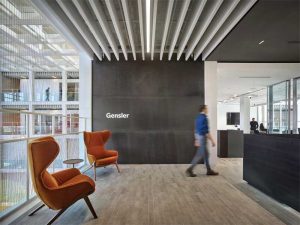
The need to decrease indoor noise levels and improve auditory comfort, speech intelligibility, and sound privacy by specifying high-performing, sound-absorbing surfaces or objects is well-established in building standards, guidelines, and rating systems. Building owners and occupants expect their spaces to function well acoustically, even if they do not verbalize this during the design phase or the building is not required to comply with any specific acoustics standard.
Many specifiers can search a guideline or standard for the minimum ceiling noise reduction coefficient (NRC) requirement, then select and specify an appropriate acoustical ceiling panel system based on the NRC rating on the manufacturer’s data sheet. It can become much more perplexing, though, when a suspended acoustical ceiling is not part of the design aesthetic, the applicable standard or established performance goal is expressed in terms of NRC, and the alternative overhead sound absorbing objects do not have NRC ratings.
There are many alternative design options for implementing sound absorption over spaces when an acoustic ceiling is not desired. Vertical sound baffles and banners, and horizontal islands and clouds can be suspended as floating elements for greater visual impact. While many design options exist, the use of NRC rating as a performance metric does not. The sound-absorbing performance of these individual, hanging, acoustic objects is not quantified using NRC. Instead, their absorption is characterized using sabins, the unit of sound absorption. The number of sabins is reported and specified per object and is dependent on its size. Sabins should be specified by octave band or third octave band from at least the 125 hertz (Hz) octave band through the 4 kilohertz (kHz) octave band.
The conversion from a single-number NRC requirement found in a standard to sabins of absorption in a specification requires proper discussion with mathematical examples.
Standards and guidelines
Most building design standards, guidelines, and rating systems now have an acoustics requirements section. While not all include the same broad acoustic themes, invariably, they do all include interior sound absorption. The preferred metric for sound absorption is either minimum ceiling NRC or maximum reverberation time (RT60). The former is a performance metric for a product or material, such as an acoustic ceiling panel. The latter is a room performance metric achieved a number of different ways using different materials on different surfaces. Minimum ceiling NRC is more straightforward for architects and specifiers to use because manufacturers typically publish NRC values of their products. RT60 requires complex take offs and calculations and can only be verified by conducting acoustic measurements with instrumentation after construction—far beyond the capabilities of most architects and specifiers.
Version 2 of the WELL Building Standard (WELL v2) by the International WELL Building Institute (IWBI) requires learning spaces to have a minimum ceiling NRC of 0.90 to gain the full two credits available in feature S05 of the Sound Concept. Additional points can be credited in feature S04 for also having an RT60 no greater than 0.60 seconds in rooms less than 283.2 m3 (10,000 cf). The Green Globes Assessment Protocol for Commercial Buildings by the American National Standards Institute (ANSI) and the Green Building Initiative (GBI) (ANSI/GBI 01-2019) requires open office areas to have a minimum ceiling NRC of 0.90 or a maximum RT60 of 0.40 seconds. Unlike WELL v2, which offers points for meeting the NRC requirement and additional points for meeting the RT60 requirements, Green Globes offers points for either, but not both, compliance paths.
Other standards, guidelines, and rating systems use NRC or RT60 exclusively. For example, Acoustical Performance Criteria, Design Requirements, and Guidelines for Schools, Part 1: Permanent Schools by ANSI and the Acoustical Society of America (ANSI/ASA S12.60) only uses maximum reverberation time. A core learning space less than 283.20 m3 (10,000 cf) must have a reverberation time no greater than 0.60 seconds. A minimum ceiling NRC compliance path is not provided. Conversely, the National Institutes of Health (NIH) Design Requirements Manual designates ceilings have a minimum NRC rating. Reverberation time is not used. Since building standards, guidelines, and rating systems use minimum ceiling NRC and/or maximum RT60, specifiers and designers are not used to acousticians and more savvy manufacturers telling them NRC does not apply to acoustical objects like baffles, banners, clouds, and islands. As a result, there is a potential knowledge gap between selecting and specifying these types of sound absorbers and knowing the intent of the acoustics requirements in the standards, expressed in NRC or RT60, are being met.




